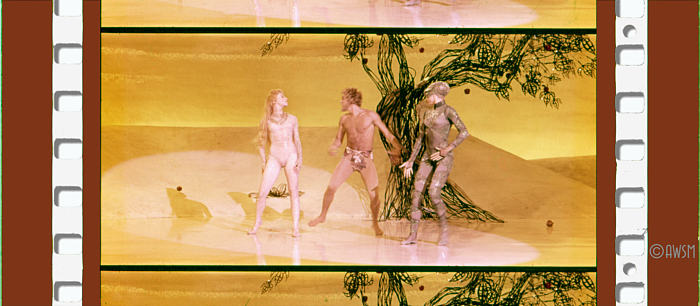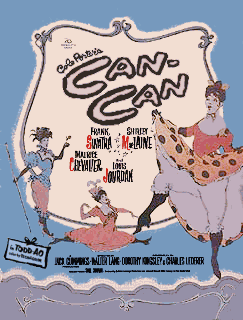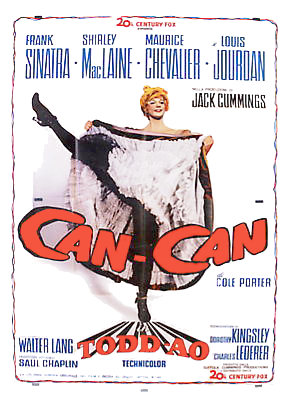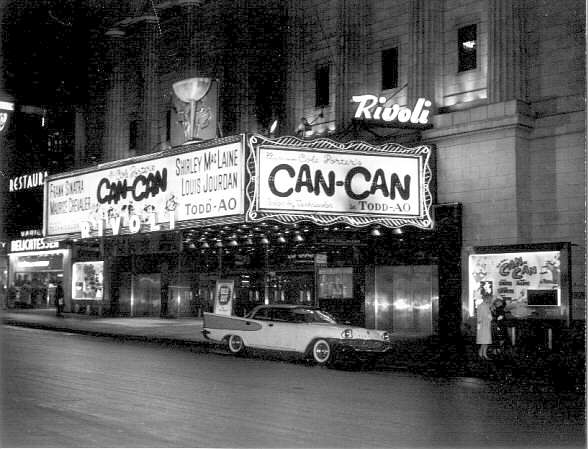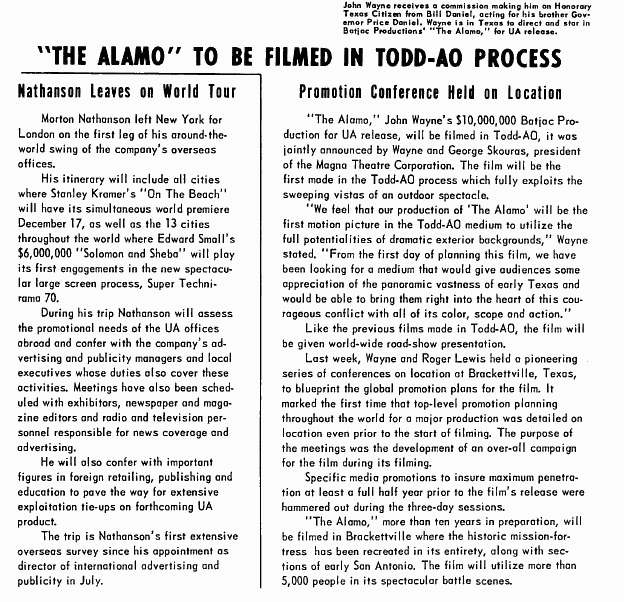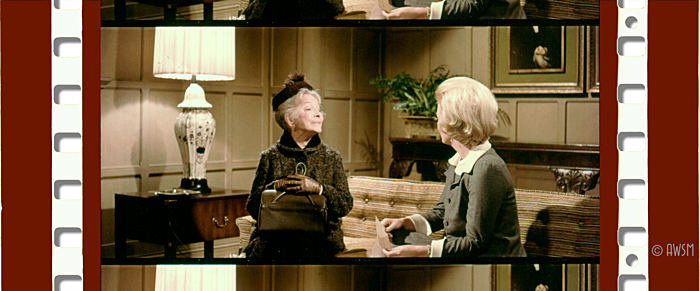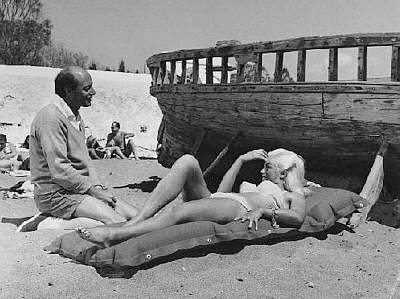|
|
|
|
|
|
|
|
|
|
|
|
70mm Film Finally Makes The Big Time
The movies have frequently played an unexplainable role in world politics, especially during the cold war. Cinerama had completely embarrassed the Russians at international trade shows in Thailand and Damascus, Syria, and they countered with their own version. No such thing happened with Todd-AO, though the Soviets did develop a similar system, but a Todd-AO film set was the scene of a widely publicized bit of histrionics by Soviet premier Nikita Khrushchev in 1959. While touring the U.S., he and his lovely wife* visited the 20th Century-Fox set of Can-Can and while watching the above scene being filmed he was so disgusted by the skimpy costumes, (that's the late Juliet Prowse on the right and Shirley MacLaine on the left), that he made his famous "We will bury you" statement. There's little other reason to remember Can-Can.
Seen at right foreground, Nikita Khrushchev, judge of bovine beauty, tractors, ICBMs, and decadent Capitalist motion pictures. He's the one wearing a tie.*I'm attempting humor here. Mama Khrushchev was butt-ugly.
Ooh La La! Above left, American poster and above right, the French poster.
New York's Rivoli Theatre ran more Todd-AO films than any other.
THE TODD-AO PRINT AND SCREEN CREDIT QUESTION

Graphic courtesy of David Coles Trade paper ad for Rodgers & Hammerstein's 1962 remake of State Fair which was about to enter into production. About all that is accurate in the ad is Pat Boone's presence. Early on the project looked like a turkey. José Ferrer took over the directorial duties and Todd-AO, which was still partly owned by R&H, was replaced with CinemaScope. Ann Margret sang songs originally written for Dick Haymes in the 1945 Technicolor production. It was an awful mess and audiences stayed away in droves.
The little guy at the bottom of the ad must have been a Fox executive. You'll also find this chipper fellow at the bottom of one of the ads in the CinemaScope section. Is he tilted to the right because the lettering around him is in italics? We may never know.
By 1959, Todd-AO had some serious contenders for the position of alpha dog of large format film processes. Panavision's work with Technicolor and Metro-Goldwyn-Mayer resulted in 70mm presentations from the 8-perf Technirama negative and the development of the M-G-M Camera 65/Ultra Panavision 70 process. And an out and out duplicate of Todd-AO became available under the name Super Panavision 70. Todd-AO maintained a policy of demanding a percentage of the gross of a film during any 70mm showings in addition to the cost of renting their equipment and facilities. The upstart competitors made no such demands. In 1959, one film, Porgy and Bess, was released in Todd-AO. That same year, four 70mm features were released in competitive systems, Ben-Hur, The Big Fisherman, Solomon and Sheba, and Sleeping Beauty.
John Wayne had hoped to film his Alamo epic in Cinerama but that somehow didn't pan out. His second choice of Todd-AO was a much more logical one. Sadly, The Alamo turned out to be a bomb with critics and audiences. It's interesting to note that Edward Small's production of Solomon and Sheba, mentioned in the sidebar at right, was also a complete flop despite an expensive promotional campaign.
One of the last features to be photographed in Todd-AO, Ross Hunter's production of Airport, released by Universal Pictures in 1970, did not get the full blown roadshow treatment afforded the earlier films made in the system. Some cities got a 70mm print but most people saw it in conventional 35mm anamorphic. Though it wasn't of the epic nature of most other Todd-AO films, it was a decent potboiler and turned a handsome profit.
AND AT THE RISK OF REPEATING MYSELF, LOGAN'S RUN WAS NOT PRODUCED IN TODD-AO. It was produced in Todd-AO 35, a CinemaScope compatible system using optics designed by Dr. Richard Vetter.A Rose Is A Rose...
Director-Cinematographer Jack Cardiff and Producer Mike Todd Jr. shooting Scent of Mystery. More on this film can be found in the Cinerama wing.
One of the most eye catching 70mm film frames in the museum's collection was a mystery for quite a while. Thanks to film historian Dan Sherlock, we now know that the young lady in the picture is none other than Diana Dors, 1950's British Bimbo DeLuxe, in the film Scent of Mystery also shown under the title Holiday in Spain in its deodorized version. The film, for those not familiar with it, was one of the first, and mercifully last, attempts at putting smells into a theatre in sync with the action on screen. It was produced by Michael Todd Jr. who had been involved, along with his father, in both Cinerama and Todd-AO. While not officially a Todd-AO production, Mitchell Todd-AO type BFC and FC cameras were used to photograph the film which was credited as being produced in Todd-70. A rose by any other name...
After bombing as a "smellie", a deal was cut with Cinemiracle Corporation to create three panel extractions from the 65mm frame and tout Holiday in Spain as a Cinemiracle film. With the acquisition of Cinemiracle by Cinerama, Inc., the film ran in a limited number of theatres as a Cinerama show.Recently unearthed - Director-Cinematographer Jack Cardiff and Diana Dors preparing the shot seen above. Cardiff has the distinction of being a pioneer in Technicolor 3-strip photography, CinemaScope, VistaVision and Technirama as well as the Todd-70 system. A remarkable career. Jack Cardiff also has the distinction of photographing some of the most beautiful women to grace the silver screen during his long and productive stint looking through a viewfinder. Jack's one of cinematography's legends, and deservedly so.
Photo courtesy of Jack Cardiff
The Least Known Todd-AO Film? Courtesy of John P. Pytlak, Eastman Kodak Company.
Billy Graham in 70mm Todd-AO
BILLY GRAHAM'S Pavilion is a showcase for the noted evangelist's 70mm Todd-AO motion picture, Man in the 5th Dimension, showing daily "on the hour."

Rev. Graham's prologue notes: "You are about to embark on a breathtaking journey through the four-dimensional world of space and time, into the realm of the fifth dimension, the dimension of the spirit . . - "
Scenes taken at Mount Palomar show our own galaxy and the galactic systems millions of light years away. The story of creation is told in the setting of the Earth's "oldest living things," the giant redwoods of California. Billy Graham demonstrates the continuity of Christian witness down through ancient and modern times to the present day.
An imported 70mm projection system is used to beam Todd-AO images to a wrap-around screen.
A World's Fair Pavilion with a 70mm Todd-AO film is a costly investment. Advertising materials may not have been too eye catching as seen above. Sales of souvenir books (right) helped cover costs.
AWSM Collection
You are on Page 12 of
DIMENSION 150 follows
< 















E-mail the author
CLICK HERE©1996 - 2004 The American WideScreen Museum
http://www.widescreenmuseum.com
Martin Hart, Curator

